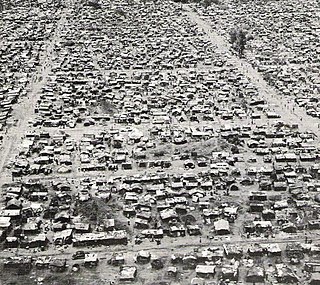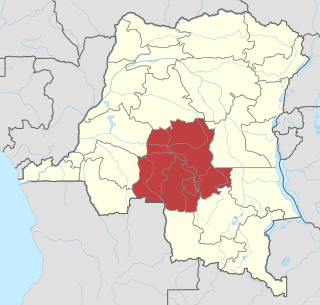The earliest known human settlements in what is now the Democratic Republic of the Congo have been dated back to the Middle Stone Age, approximately 90,000 years ago. The first real states, such as the Kongo, the Lunda, the Luba and Kuba, appeared south of the equatorial forest on the savannah from the 14th century onwards.

Luba-Kasai, also known as Cilubà or Tshilubà, Luba-Lulua, is a Bantu language of Central Africa and a national language of the Democratic Republic of the Congo, alongside Lingala, Swahili, and Kikongo ya leta.

Kasaï-Occidental was one of the eleven provinces of the Democratic Republic of the Congo between 1966 and 2015, when it was split into the Kasaï-Central and the Kasaï provinces.

The Congo Crisis was a period of political upheaval and conflict between 1960 and 1965 in the Republic of the Congo. The crisis began almost immediately after the Congo became independent from Belgium and ended, unofficially, with the entire country under the rule of Joseph-Désiré Mobutu. Constituting a series of civil wars, the Congo Crisis was also a proxy conflict in the Cold War, in which the Soviet Union and the United States supported opposing factions. Around 100,000 people are believed to have been killed during the crisis.

Kananga, formerly known as Luluabourg or Luluaburg, is the capital city of the Kasai-Central Province in the Democratic Republic of the Congo and was the capital of the former Kasaï-Occidental Province. It is the fourth most populous urban area in the country, with an estimated population of 1,524,000 in 2021.

South Kasai was an unrecognised secessionist state within the Republic of the Congo which was semi-independent between 1960 and 1962. Initially proposed as only a province, South Kasai sought full autonomy in similar circumstances to the much larger neighbouring state of Katanga, to its south, during the political turmoil arising from the independence of the Belgian Congo known as the Congo Crisis. Unlike Katanga, however, South Kasai did not explicitly declare full independence from the Republic of the Congo or reject Congolese sovereignty.

The Luba people or Baluba are a Bantu ethno-linguistic group indigenous to the south-central region of the Democratic Republic of the Congo. The majority of them live in this country, residing mainly in Katanga, Kasaï, Kasaï-Oriental, Kasaï-Central, Lomami and Maniema. The Baluba consist of many sub-groups or clans.

General elections were held in the Belgian Congo on 22 May 1960, in order to create a government to rule the country following independence as the Republic of the Congo (Congo-Léopoldville), scheduled for 30 June. The 137-seat Chamber of Deputies was elected by men over the age of 21. The seats were filled by district-based lists, although only two parties, the Mouvement National Congolais-Lumumba (MNC-L) and the Parti National du Progrès, submitted lists in more than one district.

Albert Kalonji was a Congolese politician and businessman from the Luba ya Kasai nobility. He was elected emperor (Mulopwe) of the Baluba ya Kasai(Bambo) and later became king of the Federated State of South Kasai.
The Roman Catholic Archdiocese of Kananga is the Metropolitan See for the ecclesiastical province of Kananga in the Democratic Republic of the Congo. The episcopal cathedral is the Cathédrale Saint Joseph Mikalayi in Kazumba. The Pro-cathédrale Saint Clément is in Kananga.
This is a history of Katanga Province and the former independent State of Katanga, as well as the history of the region prior to colonization.
This is a history of the Kasai region in the Democratic Republic of Congo and of the political divisions which have occupied it since human settlement began.
The Confederation of Tribal Associations of Katanga was one of the main political parties in the Belgian Congo and was led by the pro-Western regionalist Moïse Tshombe and his interior minister, Godefroid Munongo. It became the ruling party of the State of Katanga whose declaration of independence sparked the Congo Crisis.

Lulua District was a district of the Belgian Congo and the Democratic Republic of the Congo. The city of Kananga was at the center of the district, but had a separate administration. In 2015 Lulua District became the province of Kasaï-Central.

The indigenous people within the kasai basin up to Maniema understood themselves to be descendants of "AnKutshu Membele", then in the 20th century many accepted the imposed term Tetela . "Batetela" is now understood as an ethnic group of the Democratic Republic of the Congo, most of whom speak the Tetela language.

The Kamwina Nsapu rebellion, also spelled Kamuina Nsapu rebellion, was an uprising that took place in the Democratic Republic of the Congo between 2016 and 2019. It was instigated by the Kamwina Nsapu militia against state security forces in the provinces of Kasaï-Central, Kasaï, Kasaï-Oriental, Lomami and Sankuru. The fighting began after the militia, led by Kamwina Nsapu, attacked security forces in August 2016.
Emery Wafwana was a Congolese politician. He served as Minister of Interior of Luluabourg Province and was a member of the Chamber of Deputies.
Barthélemy Mukenge Nsumpi Shabantu was a Congolese politician who served as President of Kasaï Province from 11 June 1960 to January 1962 and July to September 1962. He was a president of the Association des Lulua-Frères, a Lulua ethnic syndicate, and a leading member of the Union National Congolaise. Though initially allied with nationalist Patrice Lumumba, he later denounced him and aligned himself with more moderate politicians. Following the division of Kasai Province in late 1962, Mukenge became Minister of Health and Minister of Social Affairs of the new Luluabourg Province. He later served as Governor of Kivu Province and on the Political Bureau of the Mouvement Populaire de la Révolution. He withdrew from politics in 1974 and died in 2018.
In August 1960 troops of the Republic of the Congo attempted to crush the secession of South Kasai by invading the declared state's territory. Though initially militarily successful, the attack faltered under intense international and domestic political scrutiny and the Congolese troops were withdrawn.
Louis de Jaegher was a Belgian colonial administrator. He was governor of Kasaï Province in the Belgian Congo from 1958 to 1960, just before the country became independent as the Republic of the Congo (Léopoldville).














